The Golden Age of Dublin Bookbinding
Published on 21st February 2012
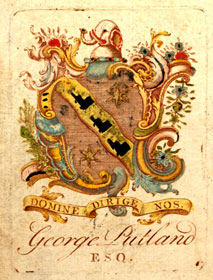 Dublin in the late 18th century was a consumer paradise. A building boom had resulted in fine streets and squares of classical houses. Interior design flourished with ornate plasterwork ceilings, painted wallpaper, beautiful furniture of polished wood and gilt, paintings and sculptures, print collections, and libraries filled with books in exquisite bindings. A stroll down Dame Street in the 1780s and 1790s would bring you by shops selling jewellery, perfume, lace, hats, silk, linen and wool, fine wines and luxury groceries, lottery tickets, music, prints and books.
Dublin in the late 18th century was a consumer paradise. A building boom had resulted in fine streets and squares of classical houses. Interior design flourished with ornate plasterwork ceilings, painted wallpaper, beautiful furniture of polished wood and gilt, paintings and sculptures, print collections, and libraries filled with books in exquisite bindings. A stroll down Dame Street in the 1780s and 1790s would bring you by shops selling jewellery, perfume, lace, hats, silk, linen and wool, fine wines and luxury groceries, lottery tickets, music, prints and books.
Right: The Coat of Arms of the Putland family, the source of the elephant motif used in the spine design of the plain calf bindings belonging to the Putland family and visible in Image 05 below
George Faulkner's Pamphlet Shop, over in Parliament street, could be depended on for the latest bestsellers direct from London, or in better value editions published by himself in Dublin. Here you could go for the latest Voltaire, that ever provoking and controversial writer; you could buy it in French, or in English translation. For your Christmas and new gifts you could buy an almanac for the coming year, or a pocket sized prayer book from Grierson's at the King’s Arms and Two Bibles in Essex Street, then you could get them beautifully bound in McKenzie's so that your friends would have something to treasure. Luke White's in Crampton Court has to be the trendiest bookshop in town, full of the latest imported books from Paris and Switzerland. But if you wanted the latest Madame de Genlis in French you could buy his own Dublin edition, which is just as good and much cheaper.
Choosing the binding is the hardest part. Should you go for a rich crimson morocco (goatskin) with an all-over design of gold ornaments, marbled endpapers, gilt edges and a silk book marker, or is that too much? Maybe something more elegant in polished tan calf with a gilt roll around the edges and keep the elaborate design for the spine? If you’re getting books bound for yourself you’d probably go for a co-ordinated approach with matching bindings and maybe use part of the family crest as the design on the spine. This would make a wonderful show in the library or study. Or go all out and have your name stamped in gilt on the top cover, at least that would keep others from borrowing and keeping your books!
For special occasions cost would not be a factor. It would be worth paying the 3s.3d. for a beautiful binding, or even up to 6s.6d. for a genuine work of art with all-over gilt designs, even though the almanac only cost 6d. Anyway, you could put it on account and you wouldn’t have to pay for three months, so you’d be able to afford it then.
So, back to the choice. You would buy your books unbound, stitched, with a blue paper wrapper, and then the time comes to decide which binding to go for. For school books mottled sheep would probably be best, strong and hard wearing and not too expensive. For the regular run of books, novels, periodicals and bound sets of pamphlets, a half leather binding on marbled boards with the title stamped in gilt on the spine, would look well on the shelves, and would be nice to handle and read. If you wanted a luxury binding with gold tooling, McKenzie’s at the College Arms in Dame Street have the best variety of ornaments, they would do a lovely floral design with urns wreathed in garlands, and maybe include some insects or birds. William and Henry Whitestone in Capel Street and John Archer in Crampton Court would have a different range of ornaments to choose from. Add sumptuous endpapers of marbled paper, or even watered silk, to give a touch of class. Gilt edges add a sense of luxury too, they look good and help to keep the dust off.
[Article author: Dr. Máire Kennedy - Special Collections]
Let’s look at some examples to help you decide.
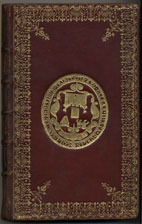 Right: Image 01
Right: Image 01
This is a prize binding from Trinity College, a batch would be commissioned by the college for the end of term, to be presented to the best students. It is bound in fine dark red morocco with an elaborate gilt border and corner tools, with the Trinity crest in the centre of both covers. This example is more ornate than most, bound in quality morocco with extra gilt decoration as well as the Trinity crest.
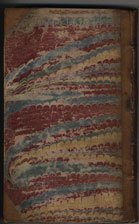 Left: Image 02
Left: Image 02
Here is your standard half calf binding, notice the nice marbled boards, a run of volumes bound like this would be very agreeable. The spines are robust, the title would be lettered in gilt, with a floral motif, the owner’s initials, or an element from their family crest stamped in the panels.
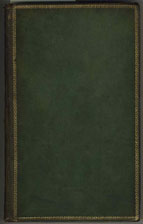 Right: Image 03
Right: Image 03
A bit more upmarket, this lovely smooth green morocco binding bordered with a gilt roll in Greek key design, would look well in any drawing room. These six volumes are Edward Gibbon’s The history of the decline and fall of the Roman Empire printed in Dublin by William Wilson in 1784.
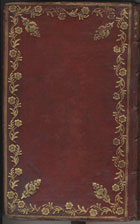 Left: Image 04
Left: Image 04
An elegant red morocco binding with a border of gilt rolls to a floral design and corner tools like this one would show off a favourite volume.
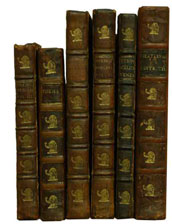 Right: Image 05
Right: Image 05
These plain calf bindings belong to the Putland family of Jervis Street and Bray, and they use the elephant motif from their coat of arms as the spine design.
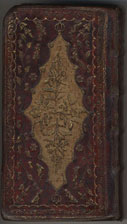 Left: Image 06
Left: Image 06
For the ladies, these beautiful pocket-sized prayer books in red morocco have lozenge-shaped onlaid cream centrepieces on both covers and elaborate gold ornamentation. Maybe a bit distracting in church!
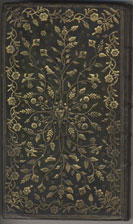 Right: Images 07 and 08
Right: Images 07 and 08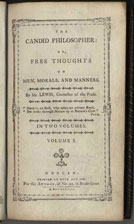
A green morocco binding with all-over gilt design of birds and flowers with a centre medallion of an Irish harp is very lovely. It encloses a copy of The Candid Philosopher, printed in Dublin by Byrn and Son in 1778, which has a nice rococo title page.
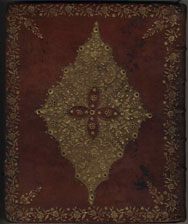 Left: Image 09
Left: Image 09
For a wonderful book of poetry by Matthew West, this fine binding in deep red morocco with large diamond onlay would look well on your occasional table, or discarded on your chaise longue.
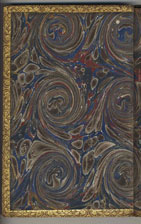 Right: Image 10
Right: Image 10
For a luxury finish you might consider gilt tooled turn-ins. In this example the turn-ins are decorated with a gilt floral roll. This looks well with the marbled endpapers.
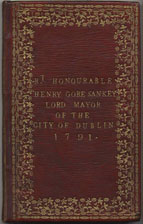 Left: Image 11
Left: Image 11
To make sure that your books do not wander away, you could consider having your name stamped on the binding. Here the Lord Mayor of Dublin, Henry Gore Sankey, 1791, has his name stamped in gilt on the top cover. The binding is of grained red morocco with a wide gilt border to a floral design.
More examples can be seen by visiting the following libraries:
- Dublin City Library and Archive, 138-144 Pearse Street, Dublin 2.
- The Chester Beatty Library, Dublin Castle, Dublin 2.
- The Edward Worth Library, Dr Steeven’s Hospital, Dublin 8.
- Marsh’s Library, St Patrick’s Close, Dublin 8.
- Trinity College Dublin, Long Room, College Street, Dublin 2.
- National Library of Ireland, Kildare Street, Dublin 2.
Read more:
- Maurice Craig, Irish bookbinding 1600-1800, London, 1954.
- Maurice Craig, Irish bookbinding (Irish Heritage Series 6), Dublin, Eason’s, 1976.
- Mirjam Foot, The decorated bindings in Marsh's Library, Dublin, Aldershot, Ashgate, 2004.
- Joseph McDonnell, Five hundred years of the art of the book in Ireland: 1500 to the present, Dublin, National Gallery of Ireland, 1997.
- J. McDonnell and P. Healy, Gold-tooled bookbindings commissioned by Trinity College Dublin in the eighteenth century, Leixlip, 1987.
- M. Pollard, ‘Plain calf for plain people: Dublin bookbinders' price lists of the eighteenth century' in Decantations, edited by Agnes Bernelle, Dublin, Lilliput Press, 1992, pp. 177-86.